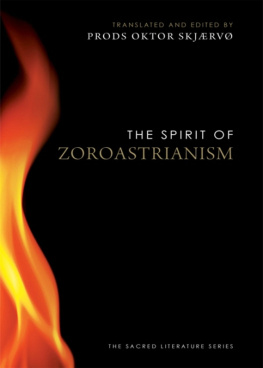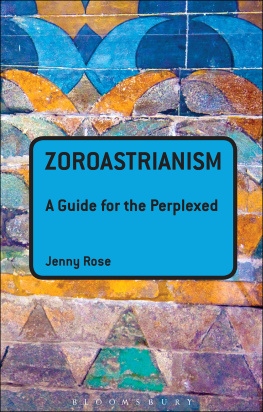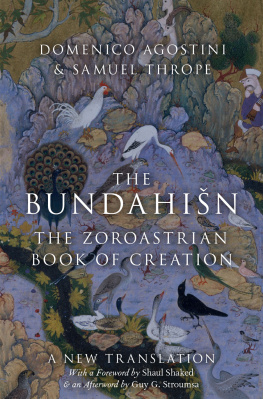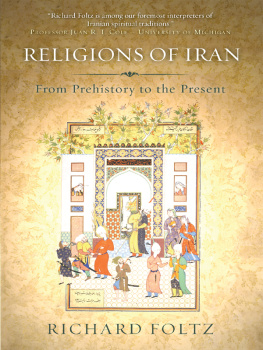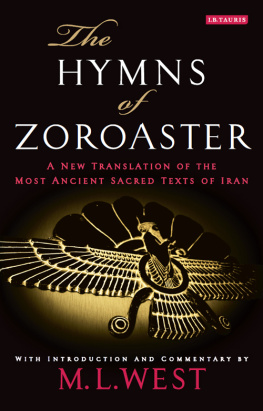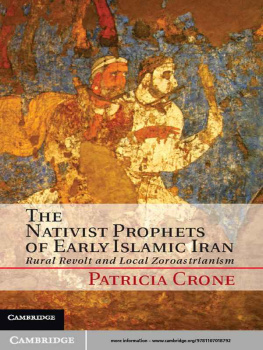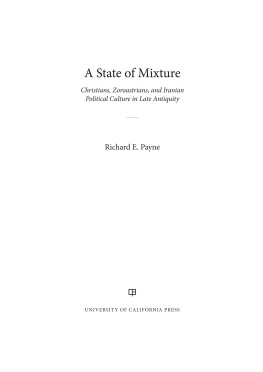First published 2001
by Routledge
2 Park Square, Milton Park, Abingdon, Oxon, OX14 4RN http://www.routledge.com
Transferred to Digital Printing 2006
2001 Philip G. Kreyenbroek
Typeset in Palatino by LaserScript Ltd, Mitcham, Surrey
All rights reserved. No part of this book may be reprinted or reproduced or utilised in any form or by any electronic, mechanical, or other means, now known or hereafter invented, including photocopying and recording, or in any information storage or retrieval system, without permission in writing from the publishers.
British Library Cataloguing in Publication Data
A catalogue record of this book is available from the British Library
Library of Congress Cataloging in Publication Data
A catalogue record for this book has been requested
ISBN 070071328X
Publishers Note
The publisher has gone to great lengths to ensure the quality of this reprint but points out that some imperfections in the original may be apparent
Preface
The Parsis are a small group of Iranian descent who have preserved their communal, cultural and religious identity in India for the last ten centuries at least. This book is primarily concerned with the religion of this community, a branch of the ancient faith known as Zoroastrianism. It aims to elucidate the contemporary realities of Parsi religious life on the basis of narrative interviews, a method that is increasingly used in other fields of research and whose value for the study of religion is gradually being discovered. Like all other methods, qualitative research has its inherent limitations. It seems particularly appropriate in this case, however, because it helps to fill some of the more glaring lacunas in our knowledge of modern Parsi religion by throwing light on its subjective and devotional sides. Few adequate descriptions seem to exist of the way in which Parsis understand and practise their religion, and although a considerable amount is known about the classical Zoroastrian tradition as it developed in the Iranian homeland until the 9th or 10th century CE, it cannot be taken for granted that the connection between this ancient tradition and modern Indian realities is simple and straightforward.
An important reason for the scarcity of our information on modern Indian Zoroastrianism is that the interest of most Western academics and some modern Parsis has so far been focused predominantly on the ancient scriptural tradition. This classical tradition, in which doctrine and religious teaching play a major role, is in fact often held to represent the norm for all forms of the religion. That implies that contemporary beliefs, attitudes and practices for which no obvious foundation can be found in the scriptural tradition tend to be dismissed as mistaken or corrupt. A strong preoccupation with classical theology, in other words, has led to an academic understanding of Zoroastrianism which tends to be used as a prescriptive definition of that religion a state of affairs that has not encouraged the study of the religious lives of modern Parsis as valid expressions of Zoroastrianism.
It is of course true that in some religions the contemporary tradition is strongly influenced by an official form of the faith, which is based on an authoritative interpretation of a canon of sacred texts and is often upheld by a learned priesthood. In such cases, change generally results from interaction between the views of theologians representing official religion, and the needs and perceptions of ordinary believers. Where the daily realities of the latter make a traditional view seem outdated, the former usually adapt their teachings. On the other hand, official religion can act as a brake when developments threaten to happen too fast or be too radical, thus preventing a situation where modern beliefs are obviously at variance with earlier teachings. Where this is the case, the role of official religion in the development of contemporary religious traditions is obvious and important.
Zoroastrianism, on the other hand, differs from most other great religions in that its academic theology virtually stopped evolving some centuries after the Islamic conquest of Iran (7th century CE). As Islam consolidated its hegemony in the centuries that followed, Zoroastrian communities gradually became too marginal and poor to support the substantial group of scholar priests who until then had kept the intellectual and theological traditions of the faith alive. The remaining priestly scholars, it seems, began to devote their energies to writing down as much as they could of the ancient learned tradition, which until then had largely been transmitted orally. Later generations of priests, both in Iran and India, continued to study some of the knowledge contained in these writings, but few further attempts were apparently made to formulate an authoritative Zoroastrian system of doctrines in the light of the conditions of the times. For a long time, it seems, the religious life of Zoroastrian communities was such that this caused few problems. For the Parsis this changed in the early 19th century, when confrontations with Christianity and challenges posed by Western religious concepts and attitudes had the effect of calling into question the validity of traditional religion generally, and priestly learning in particular. The 19th century further saw many Parsis receiving a Western-type education and witnessed the rise of a powerful Parsi merchant class. All this led some Parsis to seek to define their theology, and contributed to the emergence of a series of religious movements springing from a sense of disenchantment with traditional Parsi religion. These movements, some of which still play a role in the life of the community today, generally aim to rediscover or redefine the teachings of Zoroastrianism, and in some cases the deeper meaning of ritual, with a view to establishing a reconstructed, authentic form of the religion.
One of the reasons why these developments have not so far led to the emergence of a unified reformed Zoroastrianism is clearly to be sought in the profound dissimilarities between the teachings of the movements themselves. A further reason may be that a very different understanding of the nature and function of religion emphasising orthopraxy, faith, and a devotional life that is not strongly based on intellectual beliefs is deeply ingrained in the community, and most of its members have presumably been reluctant to rethink their religious lives deeply enough to accept a form of religion based on unfamiliar assumptions. However, the activities of the religious movements did have the effect of introducing to the community a theoretical conception of Zoroastrianism as a religion largely based on the authority of the classical tradition, intelligible teachings, and personal belief.
The relationship between the classical and modern traditions among Indian Zoroastrians is therefore a complex one. The Parsi tradition is of course ultimately based on classical Zoroastrianism; in the course of time it seems to have developed along its own lines in many respects, and it is now again influenced by the ideal of an authoritative, true form of the religion which is closely associated with ancient teaching. However, as we saw, there is no consensus as to the precise character of this ideal form of Zoroastrianism and its impact on the religious lives of many Parsis is demonstrably minimal.
Clearly, these factors contribute to the difficulty of studying modern Parsi Zoroastrianism. As was noted earlier, few Western scholars have so far paid much attention to this form of the religion. The Parsis' own writings on religious questions are heterogeneous; apart from some esoteric works, their publications are usually influenced to some extent by Western-inspired definitions of religious concepts. If the views advanced in these works had achieved the status of a new orthodoxy, or even contributed to the emergence of a consensus on Zoroastrian teaching, they could presumably have served as a legitimate basis for research on Parsi religion. Since this is plainly not the case, however, it would seem that modern Parsi religion cannot be adequately understood on the basis of written sources alone, whether classical or modern. The traditional, deductive or prescriptive method of research, which accepts an authoritative form of a religion as a norm in the light of which other forms or aspects of the faith can be understood, therefore seems problematic in this case. As an alternative an inductive, descriptive approach is employed here, studying the evidence of personal testimonies with a view to arriving at a more general understanding. Although they cannot yield statistically significant data, in-depth interviews illustrate the way in which individuals understand and practise their religion. Thus they offer information which has so far been lacking, and further enable one to analyse the similarities and differences, the essential coherence or fundamental heterogeneity of the various practices, views and attitudes they describe or reflect. The evidence of a collection of narrative interviews may therefore contribute towards a tentative description of the realities of modern Parsi religious life.




